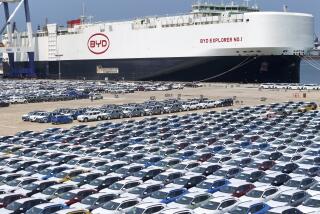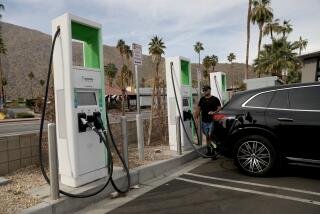Bicycle-loving China begins to go electric
- Share via
SHANGHAI — It’s a simple pleasure, but Xu Beilu savors it daily: gliding past snarled traffic on her motorized bicycle, relaxed and sweat-free alongside the pedal-pushing masses.
China, the world’s bicycle kingdom -- one for every three inhabitants -- is going electric.
Workers weary of crammed public transport or pedaling long distances to jobs are upgrading to battery-powered bikes and scooters. Even some who can afford cars are ditching them for electric two-wheelers to bypass traffic and expensive gasoline.
The bicycle was a vivid symbol of China in more doctrinaire communist times, when virtually no one owned a car. Even now, nearly two decades after the country began its great leap into capitalism, it still has 430 million bicycles by government count, outnumbering electric bikes and scooters 7 to 1.
But production of electric bikes has soared from fewer than 200,000 eight years ago to 22 million last year, mostly for the domestic market. The industry estimates about 65 million are on Chinese roads.
Car sales are also booming, but there are still only 24 million for civilian use, because few among the 1.3-billion population can afford them. And unlike in many other developing countries, Chinese cities still have plenty of bike lanes, even if some have given way to space for cars and buses.
“E-bike” riders are on the move in the morning and late at night, in good weather and bad. When it’s wet, they are a rainbow army in plastic capes. On sunny days, women don gloves, long-sleeved white aprons and face-covering sun guards.
One of them is Xu, on her Yamaha e-bike, making the half-hour commute from her apartment to her job as a marketing manager. She had thought of buying a car but dropped the idea.
“It’s obvious that driving would be more comfortable, but it’s expensive,” she said. “I like riding my e-bike during rush hour, and sometimes enjoy a laugh at the people stuck in taxis. It’s so convenient and helpful in Shanghai, since the traffic is worse than ever.”
The bikes are catching on in the U.S. and elsewhere as well. In Japan, plug-in cycles are favored by cost-conscious companies and older commuters.
“Many company workers are beginning to use them to visit clients instead of driving, to save fuel costs,” said Miyuki Kimizuka of the Japan Bicycle Promotion Institute, an industry group.
Australians use electric bicycles in rural towns without bus and train service. Tony Morgan, managing director of the Electric Bicycle Co., the continent’s largest manufacturer and retailer of e-bikes, said he had sold about 20,000 in the last decade, priced at about $800 to $1,600.
In the Netherlands, an especially bicycle-friendly country, the industry says sales passed 138,800 last year.
In India, Vietnam and other developing countries, competition from motorcycles, as well as a lack of bike lanes and other infrastructure, is an obstacle.
Indian sales have risen about 15% a year to 130,000 units, thanks in part to a $150 government rebate that cuts the cost to about that of a conventional bicycle. But e-bike sales are far outnumbered by the millions of new motorcycles taking to India’s roadways.
In China, electric bikes sell for $250 to $450. They require no helmet, license plates or driver’s license, and they aren’t affected by restrictions many cities impose on fuel-burning two-wheelers.
It costs 15 cents -- about the same as the cheapest bus ticket -- to charge a bike for a day’s use, said Guo Jianrong, head of the Shanghai Bicycle Assn., an industry group.
They look like regular bikes, and they’re only a bit heavier. Some can be pedaled; others run on battery power alone. In China, the bikes’ maximum weight is about 90 pounds, and the maximum legal speed is about 12 mph.
“For us, these are tools for transportation,” Guo said. “We’re not like Americans and Europeans, who tend to bicycle for fun or exercise.”
The e-bike doesn’t emit greenhouse gases, though it uses electricity from power plants that do. The larger concern is the health hazard from production, recycling and disposal of the lead-acid batteries. Although China is beginning to turn out more electric bikes with nickel-meter-hydride and lithium-ion batteries, 98% of the current bikes run on lead-acid types, Guo said.
A bike can use up to five batteries in its lifetime, according to Christopher Cherry, a professor at the University of Tennessee at Knoxville who studies the industry. A Chinese-made battery containing 22 pounds of lead can generate nearly 15 pounds of lead pollution, he said.
“Electric bikes result in far more emissions of lead than automobiles. They always use more batteries per mile than almost any other vehicle,” Cherry said in a phone interview.
In China, e-bike owners are paid about $30 to recycle batteries, but the work is often done in small, under-regulated workshops.
With price competition brutal among China’s 2,300 electric bike and scooter makers, manufacturers have shied away from embracing costlier, cleaner technology. But bigger foreign sales and demand for better batteries could speed improvements.
“We are trying to upgrade to lithium battery technology to be able to sell internationally,” said Hu Gang, a spokesman for Xinri E-Vehicle Group, the country’s biggest e-bike manufacturer, with sales of more than 2 million units last year.
The goal is to boost production to more than 5 million units by 2013, he said.
“It’s not that we’re that ambitious,” Hu said. “It’s just that the industry is growing so quickly.”
--
Kurtenbach writes for the Associated Press. AP writers Mari Yamaguchi in Tokyo, Kwang-tae Kim in Seoul, Rod McGuirk in Canberra, Australia, Erika Kinetz in Mumbai, India, and researcher Ji Chen in Shanghai contributed to this report.
More to Read
Sign up for Essential California
The most important California stories and recommendations in your inbox every morning.
You may occasionally receive promotional content from the Los Angeles Times.










